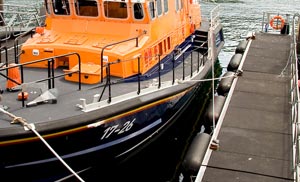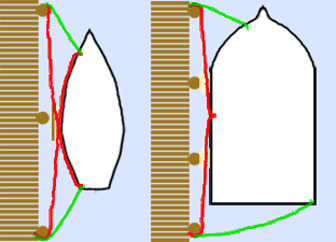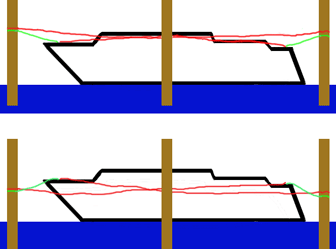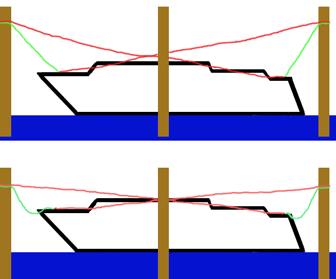 This boat is making good use of spring lines to keep the boat in place at the dock.
This boat is making good use of spring lines to keep the boat in place at the dock.When a boat is docked where the tide will go up and down, there are several ways to ensure that dock lines remain relatively tight and the boat does not move forward or back along the dock in the wind or current. This ensures that fenders will remain between pilings and the boat, rather than hanging uselessly as the boat rubs directly on the piling next to the fender.
Floating Docks and Sliding Tracks If You Have 'Em
The easiest way to deal with tide changes is a floating dock. The boat can be tied tightly to the dock and it will simply ride up and down with the dock. Some docks are equipped with sliding tracks on the pilings, and the boat can be secured with a short midship breast line to the slide car, which will move up and down with the tides. Other lines are still needed to prevent the boat from swinging, but the short line attached midships to the piling will prevent fore and aft movement. In other cases, there are pilings all around the boat with sliding rings around them or some other method of allowing the rope attachment point to slide up and down with the tide. Docks with these accessories are the easiest to tie up to, but they're not readily available everywhere you might want to tie your boat up.
Spring Lines for The Rest of Us
Most of us don't have any of that fancy stuff, but need to keep our boats riding up and down on one or two pilings, and do not want it to move enough to allow the fender to miss the piling. That means the boat can move forward and aft only the length of the fender (if hung sideways) or fender board set that rides on the piling. So how do you tie up the boat so that it remains in one place at the dock, despite changing tides, winds, and currents?
The answer is to use spring lines to prevent fore and aft motion, and long bow and stern lines to prevent the boat swinging in and out. It also helps to attach dock lines to cleats or pilings that are at the same level as the cleats on the boat at mid tide, if this is possible.
Once a boat is pulled in alongside a dock and some temporary lines are run to keep it from getting away, the first decision to be made is which piling(s) the boat will lie against. This will depend on the spacing of the pilings and the shape of the boat. If pilings are widely spaced and the hull is curved inward at the bow and stern, as in most sailboats, it may be best to set the boat to ride against one piling amidships. If pilings are spaced more closely, it is usually better to plan on having the boat ride against two or more pilings, each insulated from the hull by a fender or fender-board set. The first diagram below illustrates two possible scenarios.

The boats are held in place by long spring lines. In the case of the sailboat in the diagram, there is no midship cleat, so spring lines are run from a bow cleat leading aft to a piling adjacent to the stern, and from a stern cleat leading forward to a piling adjacent to the bow. The powerboat in the diagram has a midship cleat, and spring lines can be run forward and aft from that cleat to pilings off the bow and stern of the boat.
 The sailboat (left) lies against one piling using a fender board. The sailboat has no midship cleat, so spring lines are run from a bow cleat leading aft and from a stern cleat leading forward.The powerboat (right) lies against two pilings, and has a midship cleat. Spring lines are run fore and aft from that cleat to pilings off the bow and stern.
The sailboat (left) lies against one piling using a fender board. The sailboat has no midship cleat, so spring lines are run from a bow cleat leading aft and from a stern cleat leading forward.The powerboat (right) lies against two pilings, and has a midship cleat. Spring lines are run fore and aft from that cleat to pilings off the bow and stern.
Controlling Fore and Aft Movement of the boat
These lines will prevent the boat from moving forward or aft, keeping the fenders (which are hung from stanchions or lifelines on most boats) in place between the pilings and the boats. As the tide goes up and down, the long spring lines can remain fairly tight, since their angle to the dock (and consequently their length) will not change significantly.
The two spring lines (shown in red in the picture) do a great job of preventing the boat from sliding forward and aft along the dock, but they do next to nothing to prevent the bow and stern from swinging in and out. To do that, it is necessary to attach bow and stern lines, and those lines should also be run as long as possible, to pilings set far forward and astern of the boat. With short bow or stern lines attached to nearby pilings, the tidal changes will result in too much slack at high tides, and/or the boat hanging from taut lines at low tides.
Longer bow and stern lines set to pilings further away from the boat can be tied more tightly for the same reason long spring lines work well with changing tides: the angle to the dock changes less as the line used is made longer, so the length of the line can remain virtually constant through tide changes.
The powerboat in the illustration has a stern line attached to an outside cleat on the stern of the boat rather than to an inside cleat, which is another way of using a longer line and getting a better angle to the dock. The bow and stern lines are not as long as the spring lines, particularly in the case of the powerboat in the illustration, and must have a bit of slack to account for tide changes, but they will still prevent the boat from swinging out from the dock too much.

Properly Tied Spring Lines and Bow and Stern Lines
 A boat with properly tied springlines at low tide and high tide. The lines are attached to the piling at the level of the boat during a medium tide, so that they rise up to the boat for high tides and fall down to it for low tides.
A boat with properly tied springlines at low tide and high tide. The lines are attached to the piling at the level of the boat during a medium tide, so that they rise up to the boat for high tides and fall down to it for low tides.A view from the side shows how a boat with properly tied spring lines and bow and stern lines will look at low tide and high tide.
Note that the lines are attached to the piling at the level of the boat during a medium tide, so that they rise up to the boat for high tides and fall down to it for low tides.

Lines Too High
 WRONG: This boat has the spring lines tied too high on the piling. At low tide, the lines will be too taut, and at high tide, the bow and stern lines are slack.
WRONG: This boat has the spring lines tied too high on the piling. At low tide, the lines will be too taut, and at high tide, the bow and stern lines are slack.The next illustration shows a boat with the lines connected too high on the pilings. At low tide, the lines are taut, and the boat will sit still at the dock. At high tide, however, the boat has risen up toward the points where the lines are attached to the pilings, and the bow and stern lines are slack. With the much longer spring lines, as you can see, it makes far less difference if they are attached at the wrong height on the piling. The shorter a dock line must be, the more important it becomes that the line be attached to the piling so as to be level with the boat cleats at mid-tide.
With properly set spring lines and bow and stern lines, any boat can be made to rest alongside a piling or set of pilings. Properly deployed fenders or fenderboards will protect the boat from the dock no matter what tide, wind, or current condition may come along.
the wording and the illustrations were excellent. Who ever wrote this should probably consider writing a book. Thanks very much, Steve Durham
Agree with Steve, very useful guide. Thanks!!
I thought this was very useful I just got a boat and had problems with my first tie up. the spring line will be a big help. thanks for you illustrations Chuck Rowand
i’ve been guessing, hoping my lines were correct. your great directions and illustrations give me confidence assurance. thanks- mitch
Thank you for this excellent explanation. I have to tie up to a sea wall this summer and now I have a plan, thanks to you.
I’ve always fresh water boated, so I never had to worry about spring lines and tidal changes. I am driving the boat to Sarasota, and was worried about the tides. Not now, this article and illustrations are fantastic and very easy to follow. thanks so much!
Hi. I am new to boating and would like your advice on using/or not using spring lines on non tidal rivers. Thanks.